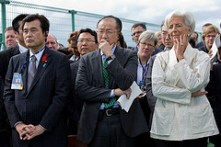
Typical street scene in Santa Ana, El Salvador. (Photo: iStock)
IMF Survey: Natural Disasters Hitting More People, Becoming More Costly
October 10, 2012
- IMF study says more people being affected by disasters, costs rising
- Caused by climate change, more people living in disaster areas
- IMF chief visits region hit by Japan's 2011 earthquake, tsunami
The number of people affected by natural disasters around the world is rising.

IMF’s Lagarde, Japanese Finance Minister Koriki Jojima (l), World Bank President Jim Yong Kim tour Sendai region of Japan (photo: Stephen Jaffe/IMF)
POST-DISASTER RELIEF
Over the past two years, 700 natural disasters were registered worldwide affecting more than 450 million people, according to a new IMF study.
Damages have risen from an estimated $20 billion on average per year in the 1990s to about $100 billion per year during 2000–10. This upward trend is expected to continue as a result of the rising concentration of people living in areas more exposed to natural disasters, and climate change.
“What I saw today was the incredible resilience, collective effort, determination, and sense of hope that comes out of the endeavor that we were shown on the ground,” said IMF Managing Director Christine Lagarde, who visited the Sendai region of Japan that was shattered by last year’s devastating earthquake and tsunami in which more than 15,000 people died and thousands were made homeless.
Lagarde attended a Sendai conference with other international leaders to discuss disaster risk and recovery, ahead of the Annual Meetings of the IMF and World Bank being held in Tokyo.
Lagarde noted that the IMF had in recent years supported countries that had suffered natural disasters, and said the institution had studied what lessons could be drawn from these countries’ experience.
“On the prevention front, in the bilateral surveillance that we do, we are trying to assess risk so that countries can be made aware of the specific risks to which they are exposed,” Lagarde added.
A new IMF working paper, “Natural Disasters: Mitigating Impact, Managing Risks” was released to coincide with the conference, organized by the World Bank and the Japanese government. A World Bank report, “Managing Disaster Risks for a Resilient Future: the Sendai Report,” will be discussed by the joint ministerial Development Committee on October 13.
Costly reconstruction
Japan estimates the direct economic cost of the disaster at 16.9 trillion yen ($210 billion) or 3.6 percent of 2011 GDP. More than half of the victims were aged 65 or over.
Power, gas, and water supplies were disrupted and roads, railways, airports, schools and other infrastructure were severely damaged.
The government allocated 18 trillion yen (3.8 percent of GDP) to reconstruction. Key expenses include temporary housing, public works, support for small businesses, transfers to affected local governments and individuals, and employment benefits and subsidies. Most roads and railways have reopened and local schools have resumed classes, while reconstruction of some 190,000 damaged buildings is ongoing.
Vulnerable especially at risk
The IMF paper said that natural disasters often lead to lower economic growth and a worsening in fiscal and external balances. They can also have a significant impact on poverty and social welfare. Developing countries, and their most vulnerable populations, are especially at risk. While natural disasters cannot be prevented, much can be done to reduce their human and economic costs.
The paper highlighted the role of the IMF in the global disaster support system. Drawing on a sample of seven countries, it reviews the financing and policy support provided by the IMF to countries experiencing natural disasters, and explores ways countries can reduce risks and mitigate the impact of disasters.
The IMF plays a small but vital role in disaster recovery, providing emergency financing and policy support to help governments design the right policy response that lays the foundation for economic recovery. Importantly, IMF support often unlocks external assistance from other sources.
Recent reforms to IMF lending facilities have increased the accessibility, predictability, and speed of financing. Several of these can be used in response to a wider range of emergencies, including for natural disasters. The IMF could continue considering ways to enhance the availability of suitable financing for disaster-related needs.
Strengthening readiness
Based on economic research by others and the sample of case studies, the paper draws the following useful lessons on ways to strengthen disaster risk mitigation and response:
• Early warning: Identify the probability of disasters and integrate these risks explicitly into economic planning frameworks. This would provide guidance on how much countries should “self insure”, and how much scarce resources to allocate to capital spending to strengthen defenses.
• Flexibility: Ensure sufficient room and flexibility within fiscal frameworks so governments can redeploy spending rapidly (and mesh existing investments into an overall recovery plan).
• Coordination: Improve coordination between multilateral institutions, donors, the authorities, and civil society. This is critical in countries where administrative capacities are limited. There is also scope for improved international coordination to consider ways to use donor assistance for risk reduction, which is likely to have a higher return than emergency assistance after the event.
• Transparency: Ensure transparency in the allocation of disaster financing to bring about the most effective use of assistance and limit imbalances and contingent liabilities to the state.
• Growth: As part of reconstruction and recovery, take the opportunity to accelerate broader growth-enhancing structural reforms.


